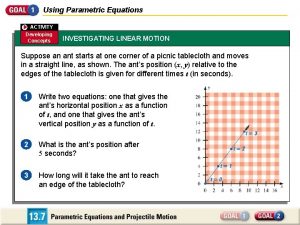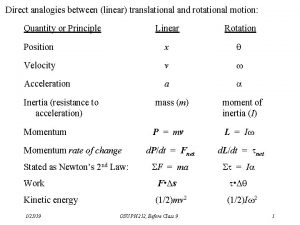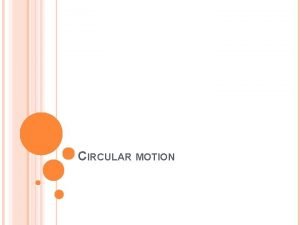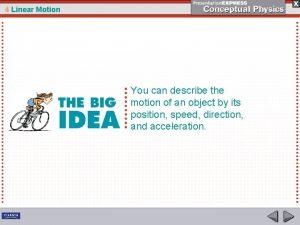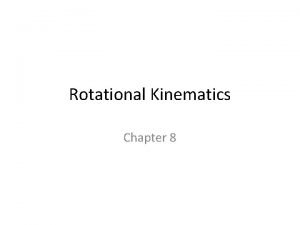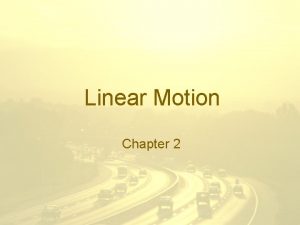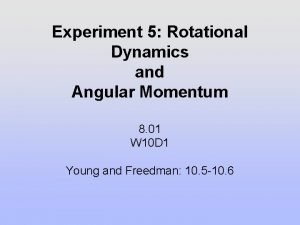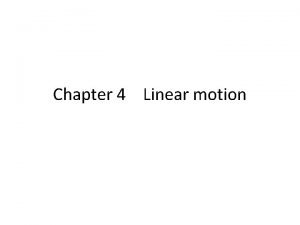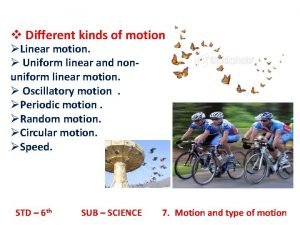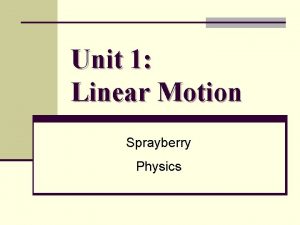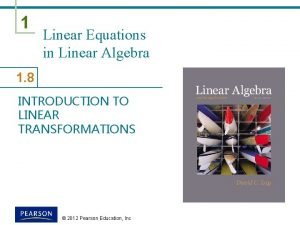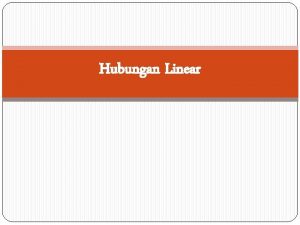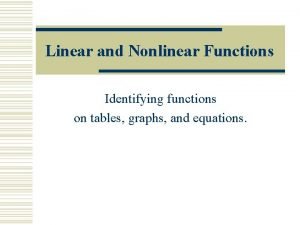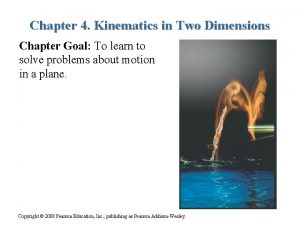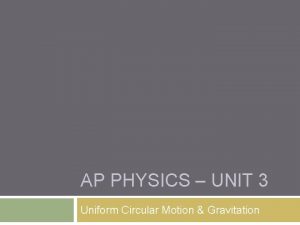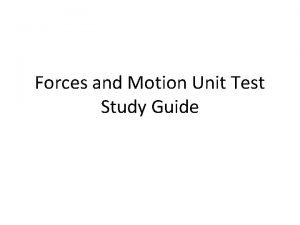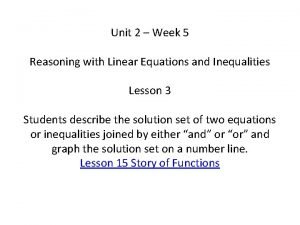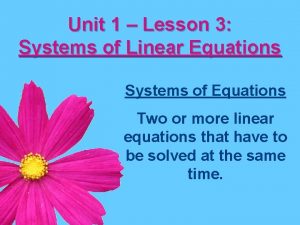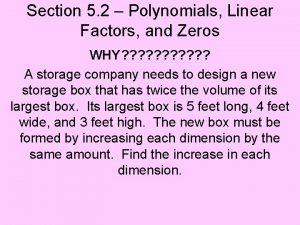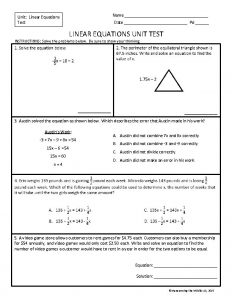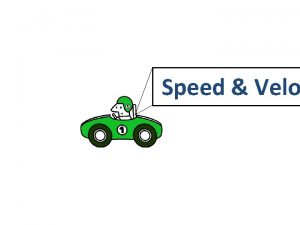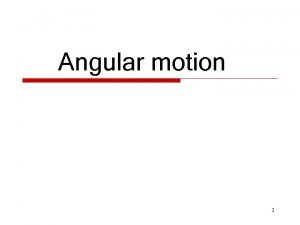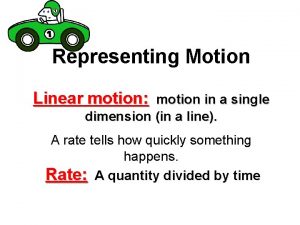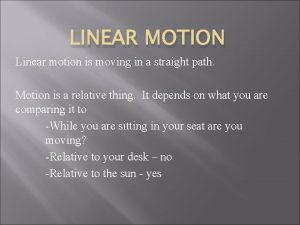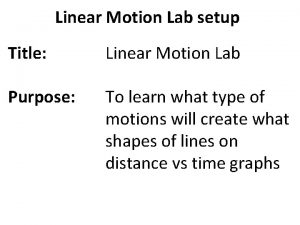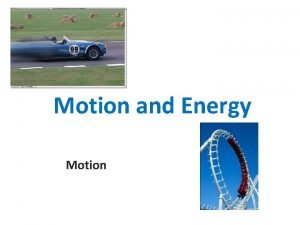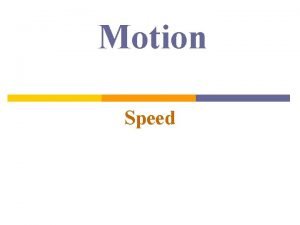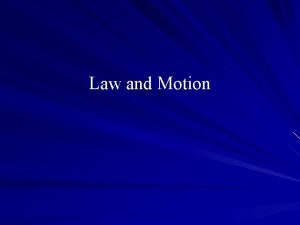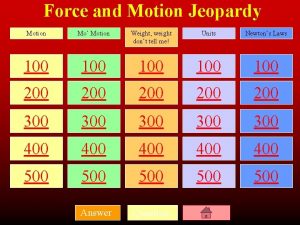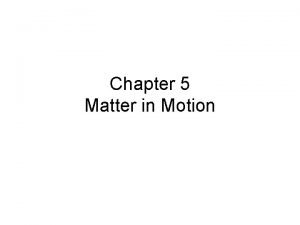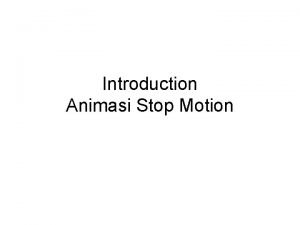UNIT 2 A LINEAR MOTION Unit 2 A




























































- Slides: 60

UNIT 2 A LINEAR MOTION

Unit 2 A: Linear Motion (Chap 2) You can describe the motion of an object by its: distance | speed | direction acceleration

2. 1 Motion Is Relative How do you know if an object is moving? • Is your book moving? The book is at rest, relative to the table, BUT It’s moving at about 30 km/s relative to the sun. An object is moving if its position relative to a fixed point is changing.

2. 1 Motion Is Relative An object’s motion must be described relative to something else. • shuttle 8 km/s relative to Earth below • race car 300 km/h relative to the track • The speeds of things on Earth are usually measured relative to the Earth’s surface.

Problem: You are a passenger in a car stopped at a stop sign. Out of the corner of your eye, you notice a tree on the side of the road begin to move forward. WHAT? ? You have set yourself as the reference point as the car rolls slightly backward. Reference point Motion

2. 2 Speed 400 yrs ago, people described motion as simply “slow” or “fast. ” Galileo was the first to measure speed by the distance covered and the time it takes. distance speed = time 5 mi avg. speed = 0. 20 h avg. speed = 25 mi/h

2. 2 Speed

2. 2 Speed Instantaneous Speed Cars do not always move at a constant speed. You can tell the speed of the car at any instant by looking at the car’s speedometer. instantaneous speed: the speed at any instant average speed: total distance time

2. 2 Speed If we know average speed and travel time, the distance traveled is easy to find. distance speed = time distance = speed x time Example: If your average speed is 80 km/h on a 4 -hour trip, then how far did you travel? distance = 80 km = x km 1 h 4 hr 320 km

2. 2 Speed If a cheetah can maintain a constant speed of 25 m/s, it will cover 25 meters every second. At this rate, how far will it travel in 10 seconds? distance = (25 m) = (x m) = (1 s) 10 s 250 m distance = speed x time In 1 minute? distance = (25 m) x (x m) (1 s) (60 s) = 1500 m

2. 2 Speed The speedometer in every car also has an odometer that records the distance traveled. If the odometer reads zero at the beginning of a trip and 35 km a half hour later, what is the average speed? distance speed = = time 35 km 0. 5 h = 70 km/h

Quick Quiz! 1. Jake walks east through a passenger car on a train that moves 10 m/s in the same direction. Jake’s speed relative to the car is 2 m/s. Jake’s speed relative to an observer at rest outside the train is ___. A. 2 m/s B. 5 m/s C. 8 m/s D. 12 m/s 2. 1

Quick Quiz. 2. A gazelle travels 2 km in a half hour. The gazelle’s average speed is ___. A. 1/2 km/h B. 1 km/h C. 2 km/h D. 4 km/h 2. 2

2. 3 Velocity In physics, Velocity: is speed in a direction. • speed: 60 km/h • velocity: 60 km/h north, or right, or down… ∆: change in… (final – initial) (df – di) m ∆d (m/s) v= t t s

2. 3 Velocity If either the speed or the direction (or both) changes, then the velocity changes. • constant speed and constant velocity are NOT the same. The car speedometer always reads 30 km/h. Is speed constant? Y Is velocity constant? N

2. 4 Acceleration We can change an object’s motion by changing its speed, its direction, or both. Acceleration is the rate at which velocity changes. ∆v (v – v ) a= t f t i acceleration can increase or decrease speed,

2. 4 Acceleration We can change an object’s motion by changing its speed, its direction, or both. Acceleration: is the rate at which velocity changes. ∆v (v – v ) a= t f t i acceleration can increase or decrease speed, deceleration is really negative acceleration (–a)

2. 4 Acceleration concerns change in velocity so any a change in direction is acceleration. The car speedometer always reads 30 km/h. Is velocity constant? N Is there an acceleration? Y

2. 4 Acceleration a in the same direction as v : speed up

2. 4 Acceleration a in the same direction as v : speed up a in the opp. direction as v : slow down

2. 4 Acceleration a in the same direction as v : speed up a in the opp. direction as v : slow down a at an angle to v : change direction

2. 4 Acceleration v units are in distance per time: (m/s) • a is the change in v per change in time. ∆v a= t m/s or m s s 2 • a units are v per time: (m/s per s) or (m/s 2) • changing v from 0 m/s to 10 m/s in 1 s, a is… 10 m/s – 0 m/s 10 m/s a= = = 10 m/s 2 1 s 1 s

2. 4 Acceleration In 5 seconds a car increases its speed from 8 m/s to 18 m/s, while a truck goes from rest to 10 m/s in a straight line. Which undergoes greater acceleration? 18 m/s – 8 m/s 10 m/s acar = = = 2 m/s 2 5 s 5 s 10 m/s – 0 m/s 10 m/s atruck = = = 2 m/s 2 5 s 5 s

Quick Quiz! 1. Constant speed in a constant direction is… A. constant velocity. B. constant acceleration. C. instantaneous speed. D. average velocity. 2. 3

Quick Quiz. 2. A vehicle undergoes acceleration when it __. A. gains speed. B. decreases speed. C. changes direction. D. ALL of the above 2. 4

2. 5 Free Fall: How Fast Imagine there is no air resistance and that gravity is the only thing affecting a falling object. • An object moving under influence of the gravitational force only is said to be in free fall. During each 1 s of fall, v increases by 10 m/s. This gain in v in m/s is a in m/s 2.

2. 5 Free Fall: How Fast g is used for the acceleration due to gravity Although g varies slightly based on altitude, its average value is nearly 10 m/s 2 t = 0 s, v = 0 m/s t = 1 s, v = 10 m/s t = 2 s, v = 20 m/s t = 3 s, v = 30 m/s t = 4 s, v = 40 m/s g = – 10 m/s 2 v = vi + at (a is g) t = 5 s, v = 50 m/s

2. 5 Free Fall: How Fast An object is thrown straight up: • It moves upward for a while. • What is v at its highest point? • Going up, vi goes to 0 m/s. v = 0 m/s at hmax • a = ? a = – 10 m/s 2 = g • It then falls downward as if it had been dropped from rest, going from 0 m/s back to vi (but downward) • a = ? a = – 10 m/s 2 = g vo

2. 5 Free Fall: How Fast What would the speedometer reading on the falling rock be 4. 5 seconds after it drops from rest? (v = ? ) v = vi + at v = 0 m/s + (– 10 m/s 2)(4. 5 s) (a is g) v = – 45. 0 m/s How about 8 seconds after it is thrown with an initial velocity of 20 m/s downward? v = – 20 m/s + (– 10 m/s 2)(8 s) v = – 100 m/s

2. 8 Air Resistance and Falling Objects Drop a feather and a coin and the coin reaches the floor far ahead of the feather. Why? Air resistance is responsible for these different accelerations. (not just g) In a vacuum, the feather and coin fall with exactly the same acceleration, g. With what objects might air resistance be small enough to be ignored?

2. 6 Free Fall: How Far t = 0 s, v = 0 m/s, d = 0 m t = 1 s, v = 10 m/s, d = 5 m t = 2 s, v = 20 m/s, d = 20 m g = – 10 m/s 2 v = vi + at (a is g) t = 3 s, v = 30 m/s, d = 45 m vavg = (30 + 40) 2 d = 35 m 1 s vavg = 35 m/s t = 4 s, v = 40 m/s, d = 80 m d = vit + ½at 2 1 s vavg = (40 + 50) 2 d = 45 m vavg = 45 m/s t = 5 s, v = 50 m/s, d = 125 m

2. 6 Free Fall: How Far An apple falls to the ground in 3 s. What is its speed upon striking the ground? vf = vi + at (a is g) v = 0 m/s + (10 m/s 2)(3 s) v = 30 m/s What is its vavg during the 3 s? vavg = (vf + vi) vavg = 15 m/s 2 vavg = (0 m/s + 30 m/s) 2 1 s 2 s 3 s

2. 6 Free Fall: How Far An apple falls to the ground in 3 s. How high above ground was the apple when it first dropped? v = 30 m/s vavg = 15 m/s d = vit + ½at 2 (a is g) 1 s d = (0 m/s)(3 s) + ½(10 m/s 2)(3 s)2 d = 45 m 2 s 3 s

Linear Motion - Practice Problems 1) An angry mob lynches a physics teacher after receiving their grades. They throw the physics teacher off a tall building straight down with a velocity of 20 m/s. The teacher falls for 3. 0 seconds landing on a stack cardboard boxes. From what height was he thrown? d = vi t + ½ at 2

Linear Motion - Practice Problems 2) Find the uniform acceleration that causes a car’s velocity to change from 32 m/s to 96 m/s in an 8. 0 s period. vf = vi + at 3) A car with a velocity of 22 m/s is accelerated uniformly at a rate of 1. 6 m/s for 6. 8 s. What is the final velocity? vf = vi + at

Linear Motion - Practice Problems 4) An airplane starts from rest and accelerates at a constant 3. 0 m/s 2 for 30 s before leaving the ground. a) How far did it move? b) How fast was it going at liftoff? d = vi t + ½ at 2 vf = vi + at

Linear Motion - Practice Problems 5) Your sister drops your house keys down to you from the second floor window. If you catch them 4. 3 m from where your sister dropped them, what is the velocity of the keys when you catch them? d = vit + 1/2 at



Quick Quiz! 1. In a vacuum tube, a feather is seen to fall as fast as a coin. This is because … A. gravity doesn’t act in a vacuum. B. air resistance doesn’t act in a vacuum. C. greater air resistance acts on the coin. D. gravity is greater in a vacuum. 2. 8

Quick Quiz. 2. If a falling object gains 10 m/s each second it falls, its acceleration can be expressed as _____. A. 10 m/s/s B. 10 m/s 2 C. v = gt D. both A and B 2. 5

Quick Quiz. d = vit + ½at 2 3. A rock falls 180 m from a cliff into the ocean. How long is it in free fall? A. 6 s 180 = (0)t + ½(10)t 2 B. 10 s 180 = ½(10)t 2 C. 18 s 180 = 5 t 2 180 = t 2 D. 180 s 5 36 = t 2 √ 36 = t t=6 s 2. 6

2. 7 Graphs of Motion Equations, tables, and pictures are not the only way to describe relationships between distance, velocity, and acceleration. Graphs can visually describe relationships.

2. 7 Graphs of Motion distance (m) distance vs. time: constant velocity (a = 0) slope = distance = v time (s)

2. 7 Graphs of Motion distance (m) distance vs. time: constant acceleration (+a) slope = distance = v time (s) parabolic curve b/c time is squared (quadratic) d = ½at 2

2. 7 Graphs of Motion distance vs. time d v: + 2 d 1 dir: → fast dir: → v: + slow a: 0 t dir: ← v: – 4 dir: ← v: – d d 3 fast slow t a: 0

distance (m) 2. 7 Graphs of Motion Describe the motion. v: 0 a: 0 v: + a: 0 time (s) • moves forward at v = 5 m/s for 5 s. • stops at 25 m (v = 0 m/s) for 5 s.

2. 7 Graphs of Motion velocity (m/s) velocity vs. time: constant velocity (a = 0) slope = velocity = a time (s)

2. 7 Graphs of Motion velocity (m/s) velocity vs. time: constant acceleration (+a) slope = velocity = a time (s)

2. 7 Graphs of Motion dir: right v : + (constant) a : 0 dir: right v : + (faster) a: + dir: left v : – (slower) a : + dir: left v : – (constant) a : 0 dir: right v : + (slower) a : – dir: left v : – (faster) a : –

2. 7 Graphs of Motion Consider the graph below. Describe the motion. (include all that are true): A. B. C. D. E. F. G. H. I. J. moving forward constant velocity positive velocity negative velocity slowing down changing directions speeding up positive acceleration constant acceleration negative acceleration + v 0 – t

Quick Quiz! The slope of a velocity-versus-time graph represents ____. A. distance B. velocity C. acceleration D. time

WARM UP Consider the graph below. Describe the motion from. . . A. t = 0 -1 s B. t = 1 -4 s C. t = 4 -9 s D. t = 9 -12 s v=– v=+ v=+ a=– a=+ a=– ←, faster →, slower At what time is v = 0 m/s at 9 s

Equations Summary N NOT given on test distance speed = time N ∆d v= t v = vi + at vavg = (vf + vi) 2 ∆v a= t d = vit + ½at 2 given on test g = – 10 m/s 2

WS Motion Graphs Begin your worksheet now. We will take all of class tomorrow to finish it.

2. 7 Graphs of Motion distance vs. time v : __ d 1 dir: __ d _____ a : __ t 2 dir: __ v : __ ____ a : __ t 3 dir: __ v : __ _____ a : __ d d t t 4 dir: __ v : __ _____ a : __

2. 7 Graphs of Motion dir: _____ v : __ (______) a : __ velocity vs. time dir: _____ v : __ (______) a : __ dir: _____ v : __ (______) a : __

https: //www. youtube. com/watch? v=r. D 0 tmg. Mdb. Qg VIDEO – Part 1 (7: 19) Acceleration & Velocity Graphs

https: //www. youtube. com/watch? v=JFZ 2 W 5 Pwlr. Y VIDEO – Part 2 (9: 53) Acceleration & Velocity Graphs

https: //www. youtube. com/watch? v=n. Ph. Rrhb 99 r. Y VIDEO – Part 3 (7: 45) Acceleration & Velocity Graphs
 Type of range of motion
Type of range of motion Periodic motion formula
Periodic motion formula An object in motion stays in motion
An object in motion stays in motion Chapter 2 motion section 1 describing motion answer key
Chapter 2 motion section 1 describing motion answer key Measuring motion
Measuring motion Section 1 describing motion answer key
Section 1 describing motion answer key Section 1 describing motion worksheet answer key
Section 1 describing motion worksheet answer key Motion section 1 describing motion
Motion section 1 describing motion In a pumpkin tossing contest in morton illinois
In a pumpkin tossing contest in morton illinois Uniform linear motion examples
Uniform linear motion examples The drive which is used for metal cutting
The drive which is used for metal cutting Analogy between translational and rotational motion
Analogy between translational and rotational motion Linear motion equations
Linear motion equations Free fall motion
Free fall motion Rotational motion equations
Rotational motion equations Rectilinear uniform motion
Rectilinear uniform motion Conceptual physics chapter 3 linear motion
Conceptual physics chapter 3 linear motion Linear motion in class test review answers
Linear motion in class test review answers Linear motion with constant acceleration
Linear motion with constant acceleration Chapter 2 linear motion
Chapter 2 linear motion Programmable logic controller
Programmable logic controller Angular momentum of disc
Angular momentum of disc Chapter 4 linear motion
Chapter 4 linear motion Which type of motion
Which type of motion Velocity vs acceleration venn diagram
Velocity vs acceleration venn diagram Chapter 4 linear motion
Chapter 4 linear motion Simple linear regression and multiple linear regression
Simple linear regression and multiple linear regression Contoh soal biseksi dan penyelesaiannya
Contoh soal biseksi dan penyelesaiannya Example of linear text
Example of linear text Linear story example
Linear story example Contoh soal persamaan non linier metode tabel
Contoh soal persamaan non linier metode tabel Linear pipeline in computer architecture
Linear pipeline in computer architecture Multimedia def
Multimedia def Left linear grammar
Left linear grammar Fungsi linear dan non linear
Fungsi linear dan non linear Contoh fungsi non linear
Contoh fungsi non linear Linear dependency
Linear dependency Linear algebra 1
Linear algebra 1 Cara penggal lereng
Cara penggal lereng Linear impulse and momentum
Linear impulse and momentum Persamaan linier simultan adalah
Persamaan linier simultan adalah Linear function vs nonlinear function
Linear function vs nonlinear function Linear or nonlinear tables
Linear or nonlinear tables Difference between linear and non linear equations
Difference between linear and non linear equations Linear and nonlinear editing
Linear and nonlinear editing Eliminasi gauss naif
Eliminasi gauss naif Closure properties of regular languages
Closure properties of regular languages O q é enredo
O q é enredo Unit 6 review questions
Unit 6 review questions Chapter 9 motion and energy answer key
Chapter 9 motion and energy answer key Si unit of circular motion
Si unit of circular motion Unit 3 circular motion and gravitation
Unit 3 circular motion and gravitation Energy and forces unit test
Energy and forces unit test Unit 4 writing linear equations
Unit 4 writing linear equations Unit 2 reasoning with linear equations and inequalities
Unit 2 reasoning with linear equations and inequalities Unit 1 lesson 3 review of linear systems
Unit 1 lesson 3 review of linear systems Unit 6 lesson 2 polynomials linear factors and zeros
Unit 6 lesson 2 polynomials linear factors and zeros Unit 2 homework 2 standard and slope intercept form
Unit 2 homework 2 standard and slope intercept form Linear function parent function
Linear function parent function Linear systems unit test
Linear systems unit test Surplus keuangan adalah
Surplus keuangan adalah








